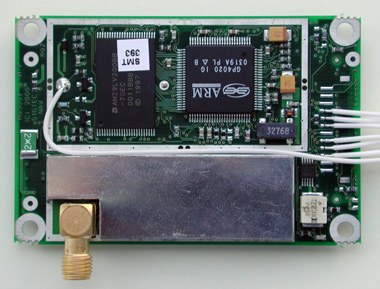Phoenix Miniature GPS Receiver
Receiver Description

Benefits of the Phoenix/MG5001 board include a high micro-processor performance which allows navigation rate up to 5 Hz without further code modifications. The CPU and memory provide enough spare capacity for adding advanced receiver features or custom specific software extensions. A revised software can be uploaded at any time via the serial interface thus increasing the flexibility of the in-orbit receiver operation. Raw code measurements exhibit a typical noise level of less than 0.4 m and carrier-phase measurements are accurate to better than 0.7 mm.
Despite a high raw data quality, the achievable single-point navigation accuracy is typically limited to 10m (3D rms) due to broadcast ephemeris errors and unaccounted ionospheric path delays. To cope with these limitations, an eXtended Navigation System (XNS) for the Phoenix receiver has been developed. The navigation system makes use of an extended Kalman filter which provides a dynamical smoothing of the raw GPS measurements. Benefits of the dynamical filtering include a substantial noise reduction and the capability to bridge periods of poor GPS visibility or outages through numerical propagation of the orbit. Furthermore, the filter supports the elimination of ionospheric path delays. The Phoenix-XNS receiver can thus achieve a real-time navigation accuracy of about 1m. The XNS functionality is embedded into the standard firmware and can be executed on Phoenix receiver boards with increased (512kB) RAM memory.
Available accessories for the Phoenix GPS receiver include a Win-XP console program, a light weight low-noise amplifier, passive patch, helix and blade antennas, as well as an evaluation kit with housing and interface board for ground testing.

For use in space applications the Phoenix receiver has been tested to tolerate a maximum total ionizing dose of at least 10 krad and to operate in vacuum within a temperature range of -20°C to +50°C. The Phoenix receiver has been selected for numerous sounding rocket projects (Texus, Maxus, Shefex) and micro-satellite missions (PROBA-2, PRISMA, Flying Laptop, X-Sat, TET, ARGO). In addition, Phoenix receivers are employed on the MAST, COMPASS-1 and UWE-3 cubesats. Delivery of unrestricted Phoenix receivers is subject to authorization by the German Bundesamt für Wirtschaft und Ausfuhrkontrolle (BAFA).
Further Reading
Phoenix Data Sheet
For information only. Subject to change without notice.
Montenbruck O., Nortier B., Mostert S.;
A Miniature GPS Receiver for Precise Orbit Determination of the SUNSAT2004 Micro-Satellite;
ION National Technical Meeting, 26-28 Jan. 2004, San Diego, California (2004).
Markgraf M., Montenbruck O.;
Total Ionizing Dose Testing of the Orion and Phoenix GPS Receivers;
DLR-GSOC TN 04-01; Deutsches Zentrum für Luft- und Raumfahrt, Oberpfaffenhofen (2004).
Lux H., Markgraf M.;
Thermal-Vacuum Testing of the Phoenix GPS Receiver;
DLR-GSOC TN 04-07; Deutsches Zentrum für Luft- und Raumfahrt, Oberpfaffenhofen (2004).
Markgraf M., Montenbruck O.,
Phoenix-HD - A Miniature GPS Tracking System for Commercial and Scientific Rocket Launches;
6th International Symposium on Launcher Technologies, 8-11 Nov. 2005, Munich Germany (2005).
Gill E., Montenbruck O., Arichandran K., Tan S. H., Bretschneider T.;
High-Precision Onboard Orbit Determination for Small Satellites - The GPS-based XNS on X-SAT;
6th Symposium on Small Satellites Systems and Services, Sept. 20-24, La Rochelle, France (2004).
Montenbruck O., Gill E., Markgraf M.;
Phoenix-XNS - A Miniature Real-Time Navigation System for LEO Satellites;
3rd ESA Workshop on Satellite Navigation User Equipment Technologies, NAVITEC'2006, 11-13 December 2006, Noordwijk (2006).
Montenbruck O.;
Phoenix-S/XNS Performance Validation;
GTN-TST-0120; DLR/GSOC (2007).
